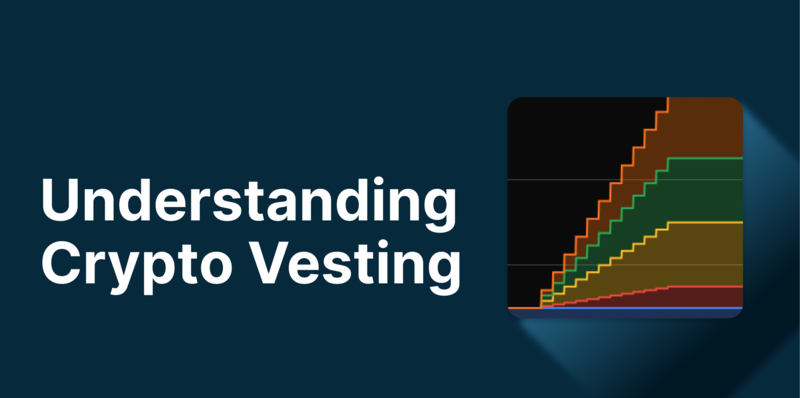Entering the market with a new crypto project is a complex, multi-stage, and risky endeavor, with investor support playing a significant role. Potential users during the pre-launch period can acquire a certain amount of tokens, thereby providing the project with the necessary funds for development. The purchase occurs by freezing tokens that have not yet been released to the public. This process is called vesting.
How Vesting Works
Vesting is a kind of agreement on the distribution of tokens between investors and project team members after their official market entry. Tokens are pre-frozen on a special smart contract or crypto wallet, allowing users to access them later. The step-by-step mechanism of vesting looks as follows:
- A coin issuance schedule is established.
- Token locking occurs.
- Tokens are gradually distributed among investors and developers.
Why is the Vesting Mechanism Used?
Vesting is necessary primarily to protect the interests of the crypto project team and its investors. Additionally, vesting encourages long-term investor participation in the project – the longer their stay and support, the more coins they receive.
As an assisting mechanism for crypto projects, vesting serves the following functions:
- Asset protection: Vesting prevents a sudden influx of tokens into the market, which would lead to their devaluation.
- Project stability maintenance: Vesting facilitates the attraction of long-term investments, encouraging investors to hold onto their tokens for as long as possible. This initial stability provides a reliable foundation for the project’s growth and development.
- Attracting new investors: A project becomes significantly more attractive to potential investors when it can freely discuss its future plans and actions. This gives a sense of reliability, which is crucial when dealing with cryptocurrencies. With vesting, a token distribution schedule is pre-approved, making it much easier for investors to plan their long-term strategies.
- Security provision: Vesting protects the project from unauthorized token sales.
Vesting in Tokenomics
An example of vesting in traditional economics could be partners of a company gaining ownership of its shares, but only being able to sell them after a year. Thus, their partnership automatically extends for at least a year.
Vesting is an integral part of a crypto project’s tokenomics. With a proper approach, it can ensure token price stability for a specified period and protect the project from a mass sell-off immediately after listing.
It’s worth noting that not all tokens of a crypto project are subjected to vesting; only a part of them are. Otherwise, liquidity would suffer. It’s crucial to monitor the percentage of tokens in vesting and those outside it – mistakes in this regard would be quite noticeable after implementation.
Types of Vesting
Vesting can be divided into several types:
- Linear: In this case, token distribution occurs evenly over a predetermined period of time.
- Accelerated: Initially, tokens are distributed rapidly, but over time, this process slows down.
- Cliff: All tokens are distributed at once after a certain period of time has passed. The period between the start of vesting and the first token payout after unlocking is called the cliff. Vesting can also be referred to as calendar-based and staged.
- Calendar-based vesting involves token distribution according to a strict calendar schedule. For example, early investors may receive only 5% of the total locked tokens in the first month after the project’s launch, but starting from the second month, they may receive 20%. Public investors may not receive anything in the first three months but then receive 20% immediately after.
- Staged vesting is characterized by token unlocking not tied to specific periods but rather to time. For example, it may occur linearly over a day.
Advantages and Disadvantages Of Vesting
Summarizing the above, we can identify the main pros and cons of the vesting mechanism for crypto projects.
Pros:
- Active investor attraction.
- Stability provision for crypto projects in their early stages.
- Protection against illegal token sales.
- Protection against token devaluation immediately after market entry (unless investors start massively abandoning them).
- Compliance with regulatory requirements for crypto projects.
- Protection of the interests of crypto project creators. Additionally, vesting contributes to decentralization and has a positive impact on token price.
Cons:
- There’s a possibility of limiting liquidity.
- It may deter investors aiming for short-term investments and quick profits (thus limiting the pool of potential investors).
- Vesting requires careful planning and implementation, which may not always be feasible for a project in terms of resources and efforts.
Ultimately, the vesting mechanism is used to maintain a balance between the interests of the crypto project team and its investors. It promotes stability and creates a relatively safe atmosphere for long-term investments.
Conclusion
Vesting emerges as a pivotal mechanism in the Crypto World, serving as a bridge between the aspirations of project teams and the expectations of investors. Its multifaceted functions encompass asset protection, project stability, regulatory compliance, and long-term investor engagement. By mitigating risks such as token devaluation and unauthorized sales, vesting fosters an environment conducive to sustained growth and development in the volatile crypto landscape.
If you want to learn more interesting facts about crypto, then check out our blog! You might like our articles “Crypto Market Overview: February” and “Crypto and Big Data”.


